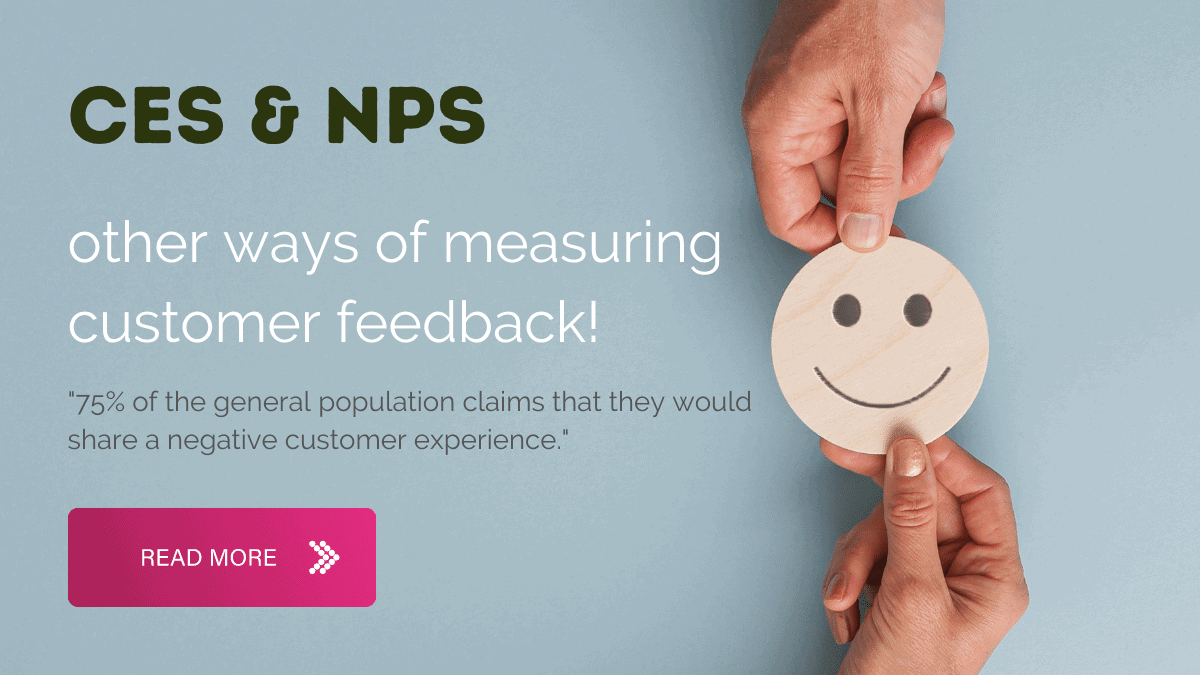We all know the term CSat (customer satisfaction), right? If you don’t use it (and you really should), you’ve probably heard about it before. However, NPS and CES are also great ways to measure customer feedback. Let’s go through it together:
What is NPS?
NPS stands for Net Promoter® Score, which refers to the fact that it measures how many of your customers are categorized as promoters.
This basically means that NPS is a great indicator of customer loyalty, and therefore, also the potential for growth in your business.
NPS is based on one simple question. More often than not, this question is: “How likely is it that you would recommend our company/product/brand/service to a friend or colleague?”
The customer’s answer is based on a 0-10 scale, where ‘0’ is ‘not likely at all’ (ouch.. ?), and ‘10’ is ‘extremely likely (Woop! ??).
You can also include an option for free commentary, so you can get extra insights into why your customer has given you the rating they have. However, you shouldn’t make this a required field, as this can scare them off, but you can encourage your customers to write down their thoughts by adding a nice headline, like: “We would love to know why you have given us this rating – we always strive to improve. ?”
How to calculate your NPS
Group your customers
When your customers have answered your question(s), you can divide them into three categories:
Detractors (0-6)
This bunch ranks your company from 0-6 and can be categorized anywhere from haters to just mildly dissatisfied. Something has gone wrong in their interaction with your brand and you should reach out to them, ask them what went wrong, and try to make up for what was, hopefully, just a mistake. ??
Passives (7-8)
These people are just that; passive. They can be leaning towards the ‘nay’ group or the ‘yay’ group. They are generally satisfied with the experience but don’t feel particularly loyal or connected to your brand. Consider asking the ‘why’ question, which will give you more insight.
Promoters (9-10)
Promoters are big fans of your work! They are the most likely to buy more, be loyal for longer, refer family/friends to you, and provide useful feedback. But don’t stop here – ring them, have them review you on Trustpilot; you need to squeeze every last drop of insight out of them.
Calculate results
Calculating your NPS is quite simple. You take the percentage of promoters and subtract the percentage of detractors.
Like this:
(no. of promoters/total submissions)*100 – (no. of detractors/total submissions)*100
Imagine you surveyed 100 customers.
If 40% were detractors and only 50% were promoters, your NPS would be 10, because:
(50/100)*100-(40/100)*100
(50% – 40% = 10)
But if you surveyed the 100 customers and only 20% were detractors, your NPS score would jump up to 30 – representing a 20% greater chance your customers will recommend you to a friend. This means that your NPS score will always be between -100 and +100.
Of course, you’d want to strive for the +100 score, but let’s face it – that’s not gonna happen!
If you want to be realistic, you should instead compare your company’s score to those in the same industry as you, as there is a big difference in NPS depending on the industry.
Department stores are generally doing really great with an average score of 58. Airlines are somewhere in the middle with an average score of 35, and internet services are not setting the bar too high with an average of 2 (we’ve all experienced this right?)
Here’s a (not exhaustive) list of different industries to compare with.
There has been a lot of speculation as to why the numbers aren’t higher. Maybe companies just aren’t doing a good enough job? Maybe detractors are more likely to review than promoters?
The latter explanation seems to make the most sense since 75% of the general population claims that they would share a negative customer experience, while only 42% would recommend a company with which they had a positive experience (according to Colloque).

Then what is CES?
CES stands for Customer Effort Score and measures, as the name implies, the effort the customer has put into getting their issue (whatever it might be) solved.
Therefore, it might even be a better predictor of the loyalty of existing customers, than NPS; better for B2B than B2C.
When measuring your CES, you should ask one simple question at the touchpoint (we’ll get into those right away) you want to examine.
“To what extent do you find the following statement to be true?:
*Your company* made it easy for me to handle my issue.”
The customer ranks their experience on a 7-point scale, ranging from very difficult to very easy. This shows how much effort a customer had to put into the buying experience, or using the product or service your company offers, and therefore, how likely they are to buy from you again.
When to use CES in customer feedback
Everyone should measure the Customer Effort Score to identify obstacles in the customer experience.
You should ask Customer Effort Questions at various points of the engagement. We can divide the customer journey into three touchpoints:
Instantly after a customer has had an engagement with your company that led to a purchase or subscription.
At this first point, CES is a great way to collect real-time feedback.
Instantly after an interaction with customer service
To get your customer’s opinion about the effort they had to put in, to resolve an issue with your customer service, it’s a good idea to use a CES survey immediately after a customer service touchpoint, e.g. after a support ticket has been solved.
To measure the overall customer experience someone has had with your brand or product.
You can also use CES to measure the customer’s overall experience with your brand shortly after purchasing a product, so they have the full experience.
You should always make sure to ask the Customer Effort questions very soon after the interaction so that the customer still has an in-depth recollection of the experience.
How to calculate CES?
CES is measured with a 1 to 7 point scale with 1 representing the highest level of disagreement and 7 the highest level of agreement, like this:
- Strongly disagree
- Disagree
- Somewhat disagree
- Neither agree nor disagree
- Somewhat agree
- Agree
- Strongly agree
When you want to calculate your average CES result, you add all the scores from the survey and divide it by the total number of answers.
It will look like this:
All scores/Total number of answers
Let’s say you received 10 answers with scores from 1-7 it’ll look somewhat like this:
(2+7+5+5+3+4+7+6+1+3)/10 = 4.2
The higher the score you get, the lower the effort your customers experienced, and the better the experience. Normally we would say that a score higher than 5 is a good Customer Effort Score.
Ways to Improve your Customer Effort Score
If you get a bad Customer Effort score, you don’t have to give up. Here you have some of the more common ways to improve.
Omnichannel customer support!
Customers expect you to be wherever they need you. By being available to your customers in multiple channels of digital support (like chat, phone, WhatsApp or social media), they choose the channel they feel most comfortable with, and therefore, use minimal effort.
Self-service tools!
Most customers would actually rather solve their own problems instead of having to contact customer service. By having a self-service option available, such as help-centers, forms, and self-help articles, the customer can easily serve themselves and solve their own problem!
Reduce waiting times!
Well, this one is quite obvious… customers don’t want to wait! They don’t want to be left on hold, they want answers immediately at every given time of the day.
The best way to solve this problem is to make sure your customer service department is using effective workflows and CX solutions. May I recommend Zendesk (wink wink ?) and a callback system from babelforce, so you literally don’t have to leave them on hold. ?
Can you really think of anything more annoying than being left on hold??
Well… moving on!
Conclusion
Now you might think why on earth should you measure the Customer Effort Score and not just use NPS or CSAT?
The reason is simple – when your customers have a low-effort experience with your company, they are also more likely to be loyal. The majority of customers who experience a high-effort interaction will probably never come back. ?♀️
However, the other side of it is that CES is most often used to measure service or product level issues, as NPS and CSat are more established ways of measuring customer experience. The issue with CES is that low effort is, of course, desirable, but it’s not the only reason why a customer becomes loyal.
No one is perfect! Not even CES or NPS (or CSat for that matter). This is why you should ideally mix a CES survey with an NPS survey so they can supplement each other, and you can get a more comprehensive result!
The bottom line is, getting loyal customers doesn’t only depend on charming your customers, but just as much on making it easier for them to complete their wanted tasks as effortlessly as possible.
About helphouse
helphouse.io is the largest Zendesk Premier Solution Provider and Implementation Partner in EMEA. They are experts in customer service and guides companies through digital customer service efficiency improvements – whether it’s by implementing a new Zendesk solution or optimizing an existing Zendesk solution.
helphouse.io has set up and customized Zendesk solutions for some of the biggest companies in Europe as well as developed helpful Zendesk app extensions.





